| |
Untangling the causal ties between antiretrovirals
and obesity: Comment. 'Body Weight Changes CASCADE Cohort'
|
| |
| |
Download the PDF here
Download the PDF here
Download the PDF here
Aug 2024
"their analysis stops short of showing ART directly causes excess bodyweight gain. Unfortunately, the wait to answer that question might not ever be over."
In summary, Pantazis and colleagues provide a novel approach to corroborating a substantial risk of bodyweight gain for people initiating modern ART. They convincingly redemonstrate that the magnitude of gain might vary by regimen and rightly conclude that bodyweight management strategies are urgently needed for people living with HIV on modern ART.10 However, their analysis stops short of showing ART directly causes excess bodyweight gain. Unfortunately, the wait to answer that question might not ever be over..... the trajectory of bodyweight gain after ART initiation also argues against a casual effect...... Indeed, in case series of acute HIV, bodyweight loss is among the commonly reported findings in approximately half of individuals.7,8
Perhaps most importantly, Pantazis and colleagues' study stops short of proving a causal relationship between ART and excess bodyweight gain. We suggest three primary reasons for this. First, as mentioned, there is no ideal control group for studies of ART and bodyweight gain. Overweight and obesity are common in the general population and whether the bodyweight gain observed in this study was excessive, as the authors suggest, expected, or even less than what would be expected in an HIV-uninfected population cannot be deduced with certainty.
-------------------------
Changes in bodyweight after initiating antiretroviral therapy close to HIV-1 seroconversion: an international cohort collaboration
"In this cohort collaboration of 5698 individuals initiating ART within 12 months of estimated seroconversion, we found that bodyweight gain on ART is not restricted to any specific drug or drug class as we observed an increase in bodyweight regardless of prescribed regimen."
Summary
Background
Understanding the reasons for and consequences of bodyweight change in people living with HIV initiating antiretroviral therapy (ART) is crucial to optimising long-term health and wellbeing. We aimed to examine bodyweight trends and associated factors among individuals with well estimated dates of HIV-1 seroconversion.
Methods
In this cohort study, we pooled retrospective data from clinical records of participants in CASCADE aged 16 years and older recruited from clinics in France, Greece, the Netherlands, Spain, Sweden, the UK, and Canada. All participants had well estimated dates of HIV-1 seroconversion, seroconverted between Jan 1, 2007, and Dec 31, 2022 (HIV-1 positive antibody test within 12 months of an HIV-1 negative antibody test, or other laboratory evidence of seroconversion), initiated ART within 1 year of seroconversion, and were previously ART-naive. Participants were followed up to the time of data pooling (May 31, 2023). We modelled bodyweight changes after ART initiation by ART class, BMI categories, and other demographic characteristics using linear mixed models.
Findings
Of 15 755 potentially eligible participants, 5698 met inclusion criteria. Of those, 5148 (90⋅3%) were assigned male at birth, 517 (9⋅1%) were assigned female at birth, and 33 (0⋅6%) had sex not known. 2778 (48⋅8%) participants initiated integrase strand transfer inhibitor (INSTI)-based ART regimens, 1809 (31⋅7%) initiated protease inhibitor-based regimens, and 1111 (19⋅5%) initiated non-nucleoside reverse transcriptase inhibitor (NNRTI)-based regimens.
The majority of participants were men who have sex with men (MSM; 4519 [79⋅3%]). Median age at seroconversion was 33⋅7 years (IQR 26⋅9-43⋅2).
Bodyweight changes differed significantly by ART class within all baseline BMI categories (BMI <18⋅5 kg/m2 p=0⋅026, BMI 18⋅5-24⋅9 kg/m2 p<0⋅0001, BMI 25⋅0-29⋅9 kg/m2 p=0⋅0021, and BMI ≥30⋅0 kg/m2 p=0⋅0033; ART class and BMI interaction p=0⋅011).
Participants with BMI less than 30 kg/m2 on regimens including both INSTI and tenofovir alafenamide gained 4⋅76 kg (95% CI 4⋅05-5⋅46) or more at 3 years.
Of those with baseline BMI 18⋅5-24⋅9 kg/m2, 31⋅3% (95% CI 29⋅5-33⋅1) on INSTI-based regimens, 25⋅3% (23⋅0-27⋅7) on protease inhibitor-based regimens, 20⋅4% (18⋅8-22⋅9) on NNRTI-based regimens, 37⋅4% (33⋅9-40⋅9) on tenofovir alafenamide-based regimens, and 38⋅4% (34⋅6-42⋅1) on tenofovir alafenamide and INSTI-based regimens had gained more than 10% of their baseline bodyweight at 3 years.
The greatest 3-year bodyweight gains by individuals on INSTI-based regimens and with BMI 18⋅5-24⋅9 kg/m2 were in women (5⋅63 kg [95% CI 4⋅92-6⋅35]), and people originating from sub-Saharan African (5⋅76 kg [5⋅06-6⋅46]), compared with MSM (3⋅82 kg [3⋅50-4⋅13]).
Interpretation
Our findings suggest a direct effect of INSTIs and tenofovir alafenamide on bodyweight gain, rather than a return to health effect. Given the known risk for cardiometabolic disease, bodyweight management needs to be part of the overall care of individuals prescribed these drugs.
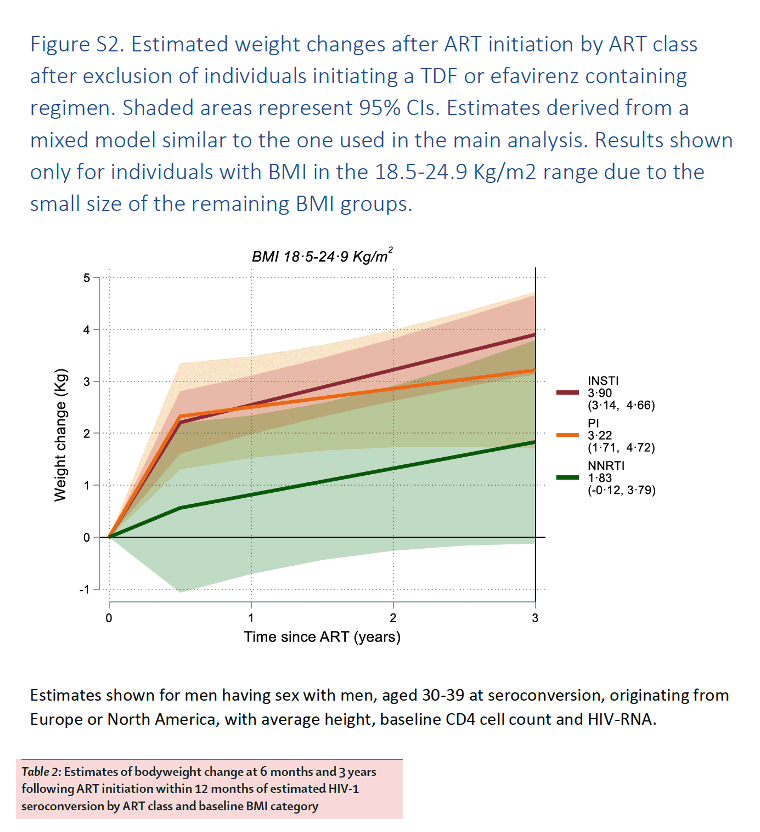
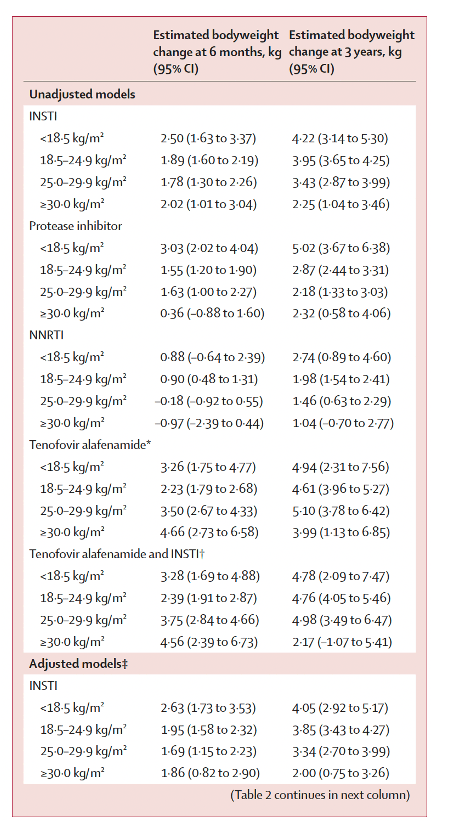
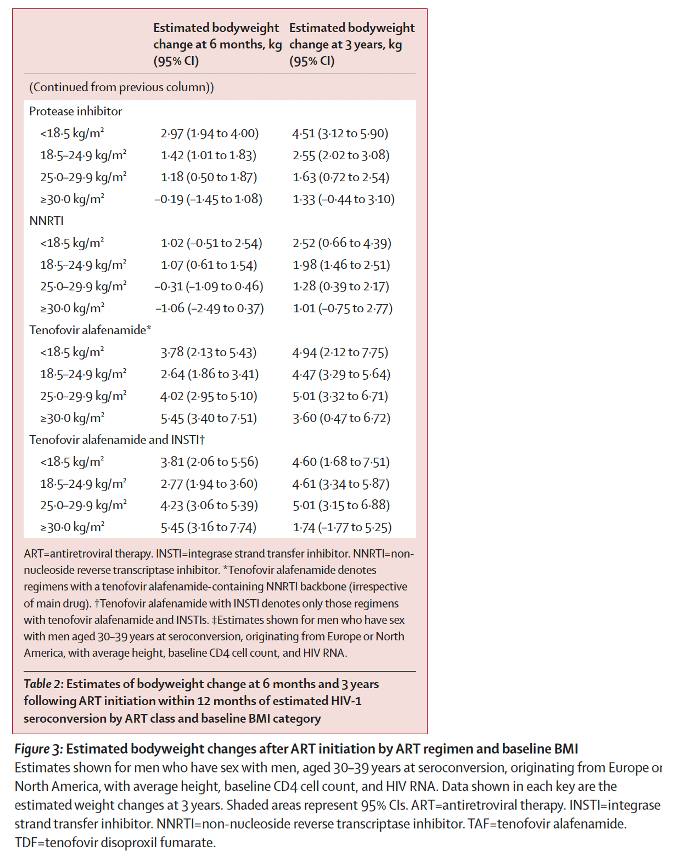
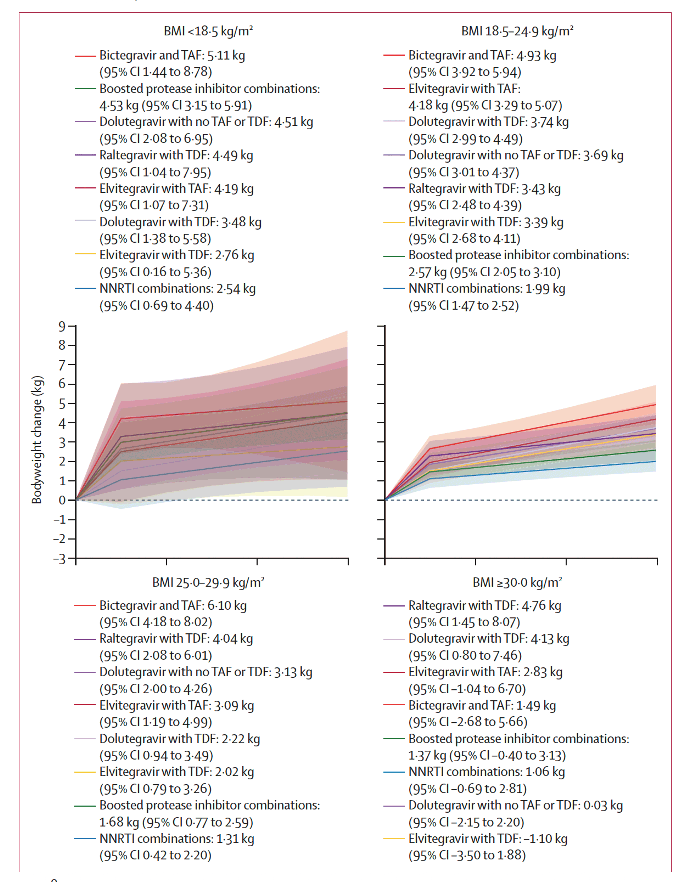
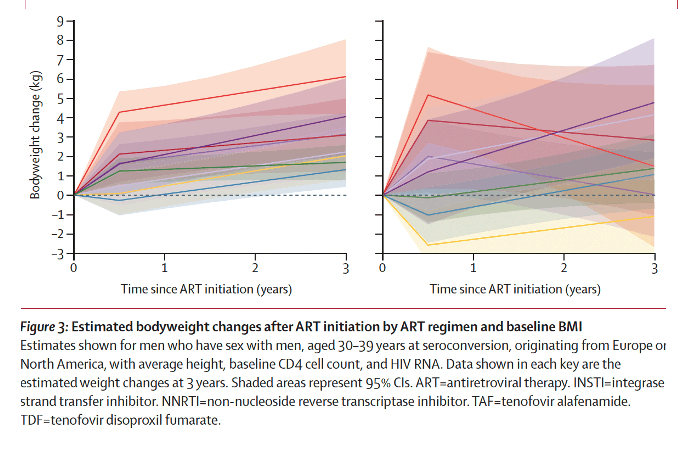
|
|
| |
| |
|
|
|